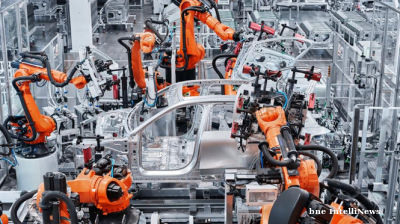Microchips are semiconductor components used in electronic devices to perform various tasks. The most important of them are calculation and data storage. They are central to technological development, because they are used for the development of artificial intelligence models, and thus in countless objects such as weapon systems and cars, the Bank of Finland institute for Emerging Economies (BOFIT) reports.
Microchips became the focus of trade policy when the United States began to limit the export of the most advanced microchips and their manufacturing equipment to China under the guise of national security. The front was later joined by e.g. The Netherlands and Japan. As a result, China is technologically far behind the most developed countries in the field. However, it has invested heavily in the sector, but the impact of the investments is still difficult to assess.
Manufacture of microchips
Microchips are three-dimensional structures in which a large number of different electronic components are connected to each other. A microchip could be compared to an apartment building, in which components are built layer by layer, and which are connected to each other. The layers consist of transistors, capacitors and other electronic components. Microchips are usually made on a round silicon wafer with a diameter of 30 centimeters. A large number of microchips are created on the disk, which are removed from the disk at the end of the manufacturing process.
In the manufacture of microchips, the layer structure is created by first coating the silicon wafer with very thin films of metals, electrical insulators and semiconductors. The microcircuit structure of each layer is created in a process called photolithography. In it, a photo-resistant substance is added on top of the coated layer. When light is applied to the photoresist material, it hardens. On the other hand, in those places where light is not directed at the photoresistant substance, it is easily dissolved with the help of chemicals. A mask is formed on top of the layer coated in this way, which protects the coating layer in the next step. In it, the circuit structure of the layer is created by etching away the coating in the desired areas in a chemical process called etching. The mask protects the coating from etching in those places where it is present, while the coating is removed elsewhere. When the hardened mask is removed and the above process is repeated, the layered structure of the microchip is formed.
In order to improve the microchip's performance and reduce energy consumption and size, the aim is to make its components, such as transistors, as small as possible. The limiting factor here is the resolution of photolithography, i.e. how precise structures can be created with the mask. This is directly proportional to the wavelength of light used in lithography.
The wavelength of visible light is at its shortest 380 nanometers (nm), so lithography has switched to ultraviolet light. The most advanced EUV (extreme ultraviolet) lithography devices use 13.5 nm ultraviolet light, and the most advanced 3-7 nm microchips have been produced with it. After EUV lithography devices, the next highest resolution DUV (deep ultraviolet) lithography devices use 193 nm ultraviolet light. They mainly have less developed chips compared to 3-7 nm microchips, but its limits have been stretched using the so-called multiple patterning method. Simply put, the lithography described above is done for each layer of the microcircuit several times instead of once. The downside of this method is that the microchip manufacturing process takes longer, which reduces the production capacity of the microchip factory. And even more important than this, the share of microchips in all manufactured chips has often been low with the multiple patterning method. The manufacturing process of a microchip is technically challenging, and some of the chips almost always do not work as desired. Therefore, in terms of the commercial potential of the manufacturing process, it is essential what proportion of the manufactured chips work and how long the manufacturing process lasts.
China has been dependent on imports of microchips and lithographic equipment
In global microchip production, China has a market share of about 20%. However, its share in the production of semiconductor manufacturing equipment is smaller, and it has been dependent on importing the most advanced lithography equipment from abroad. The only company producing EUV lithography equipment in the world is ASML from the Netherlands. However, in 2019 it joined the front to restrict US semiconductor exports to China, banning the export of EUV equipment to China. It allowed the export of DUV devices to China, but in 2023 set restrictions on the export of these devices as well. In the same year, Japan, where Nikon and Canon manufacture lithography equipment, also restricted the export of DUV equipment to China.
Last year, the United States imposed restrictions on the export of the most advanced microchips to China. The largest manufacturers of advanced microchips, such as Nvidia and Intel, are from the United States, and in practice the restrictions prevent the export of the most advanced microchips to China. Therefore, China is increasingly dependent on its domestic chip production. Since the country does not have EUV lithography equipment, it has been working to improve the performance of the DUV lithography equipment it uses. According to Bloomberg and TechInsights media, the Chinese manufacturer SMIC produced a 7 nm chip for Huawei with a DUV lithography device using the multiple patterning method. The chip was used in the Mate 60 smartphone released by Huawei last year. However, according to reports, it takes a long time to manufacture the chip and the relative proportion of working chips is small. It is possible that SMIC has been able to improve the yield of the method since then, and Chinese companies have filed patent applications for other methods for making 5nm chips using DUV devices. However, the industry sees that for the production of the most advanced chips, the EUV method is the best in terms of yield and costs.
In terms of the development of artificial intelligence models and other advanced technologies, it is problematic for China that it cannot import the most advanced chips and lithography equipment. Figure 1 shows the value of China's imports of semiconductor manufacturing equipment and microchips in recent years. The import of microchips has decreased after 2021, but the microchip export restrictions set by the US last fall, for example, do not seem to have affected imports. This may be because the restrictions only apply to the most advanced chips, and other chips can still be exported by US companies. Imports of semiconductors peaked in the summer and early autumn of last year. This may be related to the restrictions imposed by the Netherlands, according to which DUV lithography equipment could no longer be exported without an export license. According to press reports, the Chinese company acquired plenty of DUV devices in anticipation before the restrictions came into force. But it is also possible that the increase in imports is due to some other semiconductor manufacturing equipment.

US, Dutch and Japanese export restrictions have forced China to invest in all aspects of its own semiconductor sector: chip design, manufacturing and chip packaging, and semiconductor manufacturing equipment. Patents have been filed in China for parts of the EUV technology, but it is unlikely that China will be able to build a complete EUV lithography device in the coming years. China has also invested in microchip packaging, where more efficient devices are built from several microchips. The related technology is already available in China, so this is a way to get around the lack of EUV equipment.
In May, China announced the establishment of the third National Semiconductor Investment Fund. The fund has 344bn yuan ($47.3bn) in assets. At the same time, the United States, the EU and South Korea have also announced their investments in the semiconductor sector. This makes it challenging to reach the forefront of technology.
This article first appeared in the weekly comment from the Bank of Finland institute for Emerging Economies (BOFIT) here.
Tech

China’s solid-state battery breakthrough challenges the future of petrol-powered cars
Chinese researchers have announced a breakthrough in solid-state battery technology that could accelerate the global shift away from internal combustion engines, with a new design that more than doubles the range of current electric vehicles.

Iranian startup targets computer science skills gap with project-based learning model
Iranian startup CS12 introduces project-based computer science education for 13-15 year-olds to bridge university-job market gap and reduce brain drain, expanding from Tehran to Arak, Sari and Shiraz.

Uzbekistan’s unicorn ecommerce startup Uzum adds London to list of potential IPO locations
Co-founder says he's against a fast geographical expansion. Wants to win and dominate home market to demonstrate to partners fintech is capable of outperforming on other markets.

China increasing its lead in robot technology use
China is consolidating its dominance in the global industrial robotics market, accounting for 41% of the world’s operational robot stock and more than half of all new installations in 2024, according to the International Federation of Robots.
_(1).jpg)

